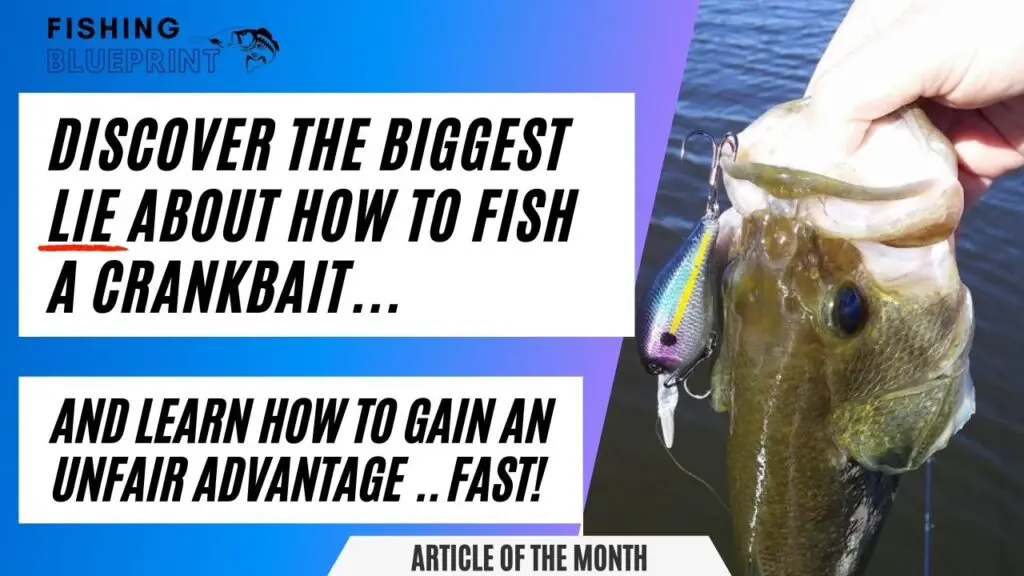How To Fish Grass For Bass? | How Do You Catch Bass In Heavy Vegetation?
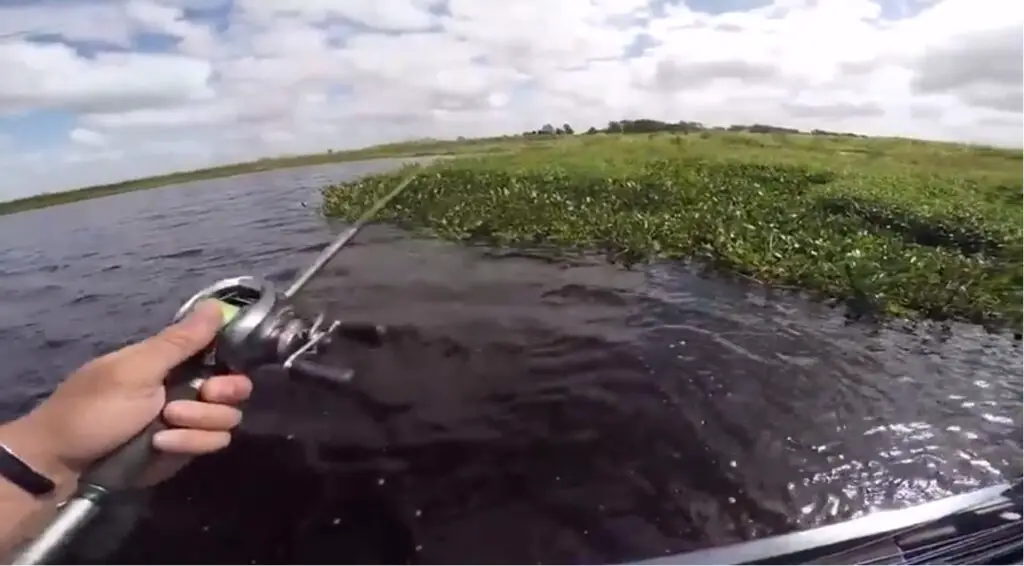
Are you trying to tackle the art of fishing in weedy lakes, heavy vegetation, or mossy ponds? I’m sure you know firsthand how frustrating it can be.
Let’s face it, that’s probably why you’re here right now.
I’m here to tell you that you can effectively catch bass in grass, whether it’s a floating vegetation mat, or in deep submerged grass you can do it with the help of this guide.
Bass fishing heavy grass effectively takes several components to line up: you need to know about water clarity, location of the bass, baits, specific seasonal changes that will influence when bass will bite, and importantly avoid getting hung up, or worse yet having your lure becoming clumped full of weeds.
Like anything worth mastering, patience, understanding the process, and practice are the means to the end.
Key Takeaways
For most anglers you bass fishing heavy grass can seem pretty exciting yet somewhat intimidating.
I hate to be a buzzkill, but if you try to teach yourself it could take you months (maybe years) just to learn how to find and catch bass in grass. So don’t go in at it alone, I’m here for you.
Listen, you’re in LUCK, I’m going to give you all the important details so you can master how to fish heavy vegetation and submerged grass like a pro and how to avoid many common mistakes in just a fraction of time!
Here is a quick and easy to follow list to help you get started fast!
- Learn how to get started bass fishing the easy way and gain the benefits of knowing where, when, and how to catch bass in just a few minutes so you’ll catch fish from any lake that holds bass!
- Carefully select the best bass baits that get the most bites which time and money. Avoid purchasing baits you’ll never use or flat out won’t catch fish!
- Learn the top 5 strategies to catching bass in grass or heavy vegetation … Ethically steal the most effective techniques from the best bass Professionals which means you will catch fish faster than the other guy down the bank!
- Like a Samurai Master, you’ll skillfully learn to choose the best rod and reel setup to enable you to confidently fish this technique and avoid choosing the wrong gear that’s not up to the task!
- Lastly, give yourself the opportunity to be a better angler. When you hear others complaining about grassy conditions, you’ll have the quiet confidence you’ll outfish them 10:1 because of the skills you’re about to learn!
If you want to learn more simply scroll down into the article below!
Learning how to fish under water grass is probably one of the most important techniques to fishing for bass, but also the hardest to learn. It’s not for the faint of heart, but for those who can master it, setting the hook and pulling out a Monster bass from a thick layer of heavy grass is exhilarating and is what keeps anglers like yourself coming back for more.
Bass Fishing Heavy Grass Mats - Floating, Emergent, Tulles & Reeds
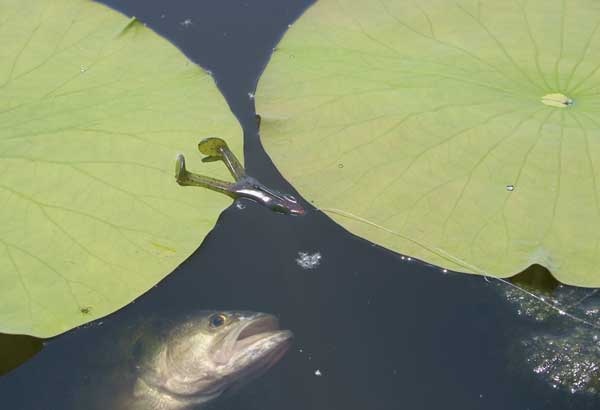
It’s best to find and fish scattered clumps of grass mats. These types will provide the perfect environment for fish.
Furthermore, mats that have access to deep water, channels, ledges, points or near current will often hold ever more and bigger bass.
Bass tends to be found closer to hard or rocky bottom, versus soft silty bottom. It is thought that bass can more efficiently launch themselves to attack its prey over a firm floor (like rocks) versus a soft silty/sandy floor composition.
In the summertime, shallow mats (mats over <4-feet of water) can often outperform mats over deeper water, especially when the mat is near current.
The best approach would be to first fish these mats at a distance by throwing a weedless topwater lure, like a floating frog. Twitch and pause the frog in the open gaps of the mat or on the edge of the mat.
If you’re working the side of the mat, pause the retrieve over “points” the mat creates by excessive vegetation growth.
Then, get a little closer to the mat for some flipping and punching…
Using your flipping rig, thread on a flipping bait, like a Zoom Brush Hog, with a pegged ¼ to ½ -ounce flipping weight. Flip and probe the outer edges first or points of the mats first.
Next switch to your heavy punching rig with a pegged 1- 1½ ounce flipping weight with a strong flipping hook.
Flip this heavy bait into the greenest part of the mat. It will punch itself through the densest layer of vegetation. If there is a big bass under that mat, odds are this is where it will be holding.
Avoid getting hung up by only penetrating your bait half way through the middle of the body
One last tip, avoid bending out your hook by purchasing heavy duty flipping hooks.
Summary
- Recognize the floating vegetation and bass tend to congregate near hard bottom or rocky floors.
- Quickly find the clumps of mats near deeper water, channels, points or near current; these will provide you the best chances of catching a fish.
- Look for holes in the mats to fish.
- Avoid areas where it’s completely covered by these floating plants. It’s likely the plants have sucked out all oxygen leaving it inhospitable for aquatic life.
- When fishing tall cattails, flip your bait as close to the base of the cattails as you can, focusing on the shady areas first.
- When fishing reeds, start on the out side edges first, then flip deeper and deeper into the reed patch.
- Avoid spending a lot of time fishing one single spot – you can always come back. No more than 5 minutes per individual grass clump.
- Since you’re fishing close it’s very important to be real quiet and not make a lot of noise with the trolling motor or banging your rods on the deck.
How to Fish Submerged Grass and Weeds
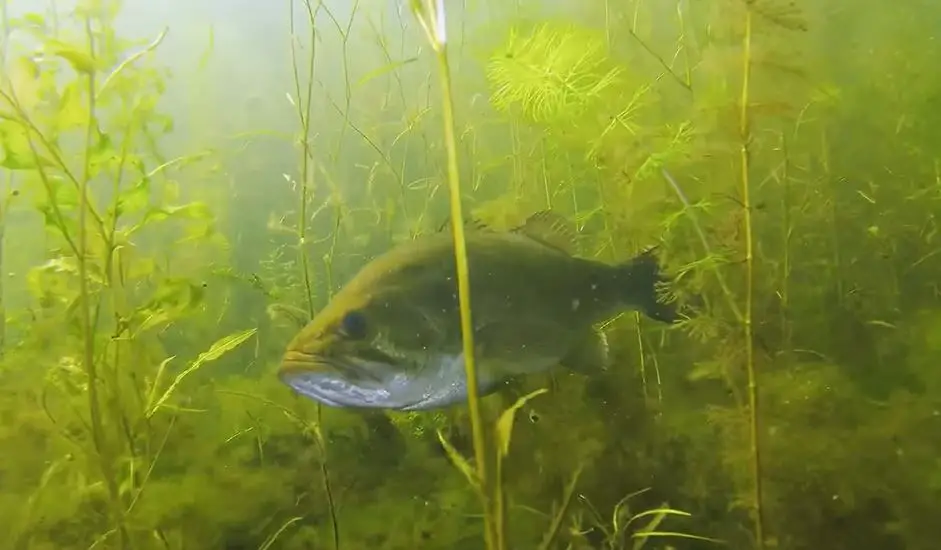
Submerged plants are rooted plants with limp or weak stems, with the majority of their vegetative mass just under the water’s surface, while tiny parts may stay above the surface.
Notably these plants are typically long and stringy.
Most submerged grasses will grow 4-20 feet below the surface depending on the water clarity.
If you really want to know how to fish grass for bass, the ideal place to fish submerged grass is to find clumps of grass. This gives the bass plenty of locations to ambush their prey.
Many anglers feel that fishing submerged grass is the hardest of all vegetation to fish. The reality is they see an area of submerged grass that can span four to six football fields long! However in actuality the bass will hold in smaller areas the size of a basketball court or even smaller! YIKES!
It is your job as the angler to find these high probability spots by using your sonar and google maps…
Here are the spots you must graph for first before doing any fishing:
- Find clumps of submerged grass next to channels, ledges or deep water
- Find a high spot or a hump in the area you’re fishing.
- Find hard bottom, or rocky bottom areas.
- Find dark holes in the submerged grass and flipping your bait into it.
Now that you identified these high percentage spots, now what?
First, start at a distance away. Using a spinning rod… yes, spinning rod, cast out a weightless or lightly weighted soft plastic swimbait in a shad color.
Try to match the hatch in color and in size. But if you don’t know what that is, choosing any “shad” color swimbait 3-4 inches in size will most likely work just fine.
Let the bait fall to the tops of the grass. Since it’s weightless it shouldn’t get all gummed up.
Slowly reel in the swimbait being sure to bump into the upper grass limbs.
Also consider jerking a soft plastic fluke over the tops of the grass.
How do you catch bass in deep weeds?
Fishing deep weeds is different from fishing in deep brush piles.
Most professionals avoid dragging a heavy weight through the weeds. It just ends up getting all mucked up.
Instead, most will chose their punching rig. Armed with a ¾ ounce Tungsten flipping weight and a super strong flipping hook.
Additionally, choose a streamline flipping bait like a Reaction Innovations Sweet Beaver creature bait or a Gambler Ugly Otter bait
Flip this heavy bait into the deepest darkest part of the submerged grass.
It will punch itself through the densest layer of vegetation. If there is a big bass in those deep weeds, odds are this is where it will be holding.
If you get a few bites on the bottom it will tell you the bass are clearly feeding on the bottom.
Once your bites start to slow switch to a punching weight with a punch skirt that’s craw colored.
Often that little flare of the skirt will draw out a few more bites.
Summary
- First find the high percentage areas before you start fishing.
- Start fishing submerged grass clumps at a distance by using a weightless soft plastic swimbait, a weightless or lightly weighted worm like a Senko or a soft plastic fluke over the tops of plants.
- Lightweight spinnerbait, underspin jig heads, shallow running crankbaits and lipless work really well when it’s breezy.
- Vertical punching works well in deep grass and weeds.
What Are The Best Baits For Fishing In Heavy Vegetation or Grass?
Whether you’re bass fishing heavy grass such as a floating vegetation mat or flipping next to cattails, catching fish fast is the ultimate goal.
But all you have to do is choose the any lure in your box right?
Well, no. It’s really not that easy to just pick any lure and expect to catch bass quickly. There is plenty to consider even before you leave for the lake.
For many of you this may be grass fishing in heavy grass 101, but it never hurts to review, and there are always new bass fisherman joining our ranks every year.
Not too long ago I wrote a full article on the best baits for fishing submerged grass and heavy vegetation. The information given here is definitively slanted toward flipping in vegetation, but it applies to flipping other structures as well like docks, bridge pilings, bluff walls.
Read More: 7 Top Secret Weedless Bass Lures for Flipping into Heavy Grass -Exposed!
Here's the best strategy fishing submerged weeds with a crankbait
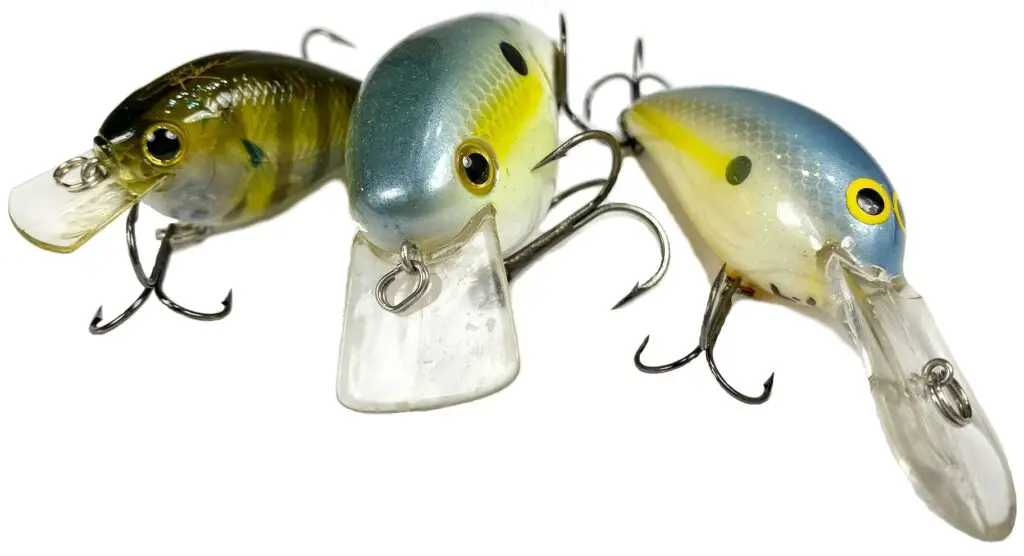
Choose your most shallow diving crankbait first.
If you do not feeling banging into the grass tops then choose a slightly deeper diving lure until you feel it tapping the tops of the weeds.
How To Avoid Being Overwhelmed When You Encounter A Lake Full Of Grass or Floating Vegetation...
When you get to the lake and you see floating mats or grass in the water, you probably know that green foliage produces habitat-rich settings, which leads to a typical dilemma for bass anglers: everything appears to be fishy!
Rather than getting overwhelmed by all of the available options, focus on identifying the places that have the best chance of producing bass.
Learning to throw the right baits to the vegetation that is most likely to elicit a strike is part of the solution.
Floating, emergent, submerged, and algae are the four primary kinds of aquatic vegetation.
Floating Vegetation
When you see a floating mat of heavy vegetation it’s probably either hyacinth, or duck weed.
It’s important to recognize these species because it’s going to determine how you fish it.
Hyacinth
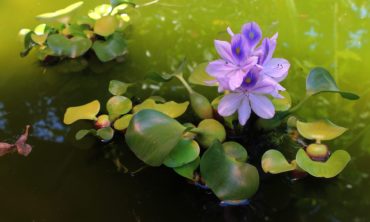
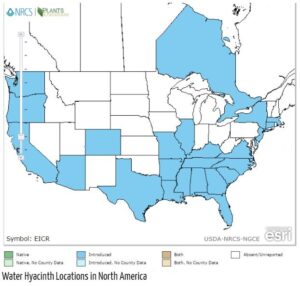 Hyacinth – Hyacinth is an invasive species and is native to the Amazon Basin in South America, according to the University of Michigan*.
Hyacinth – Hyacinth is an invasive species and is native to the Amazon Basin in South America, according to the University of Michigan*.
It develops in dense, free-floating rafts with no roots to attach them to the bottom.
This behavior makes it simple to anticipate where hyacinth can be found in lakes where it grows, especially when it’s windy!
If the wind is blowing from the west, these fish-attracting plants can be found along the east banks.
In places with little underlying structure, hyacinth makes an ideal home for bass and other aquatic creatures.
Under the canopy, hyacinth mats offer an open area and a wide shade and cover.
As a result, they frequently attract some of the biggest bass in a lake!
Duck Weed
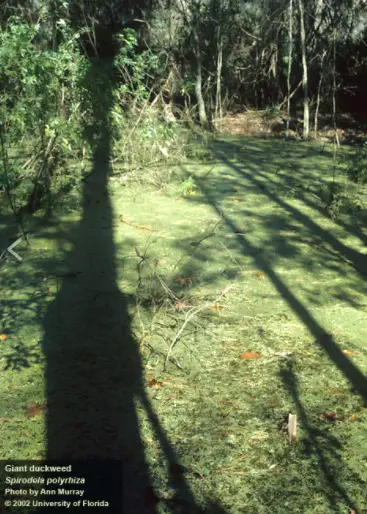
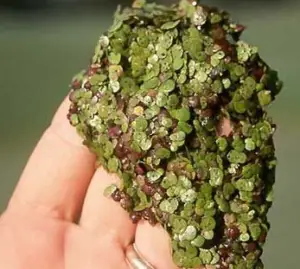 Giant Duckweed – Giant Duckweed is a native floating plant to the Midwest and southern United States.
Giant Duckweed – Giant Duckweed is a native floating plant to the Midwest and southern United States.
It generally has two to three circular leaves that are linked. Each leaf of a Giant Duckweed generally has numerous roots (up to nine) dangling beneath it. Giant duckweed has a vivid crimson underside to its leaves.
Ponds, lakes, bayous, and slow-moving streams are all common habitats for Giant Duckweed.
Although giant duckweed is native to the United States, it may be troublesome in small ponds or reservoirs.
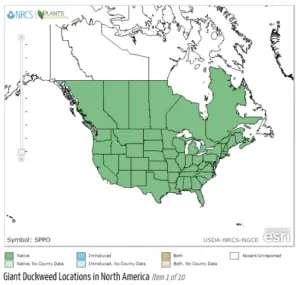
Although dense duckweed colonies provide home for micro-invertebrates, if duckweed fully covers the surface of a pond for a lengthy period of time, oxygen levels will be depleted.
By limiting sunlight penetration, these colonies will also kill submerged vegetation.
Emergent Vegetation
Emergent vegetation is defined by being anchored to the bottom.
For most bass anglers, emergent vegetation is broken up into two categories – mats and tall grasses/reeds.
Similar to the floating vegetation mats, the emergent vegetation can provide a phenomenal environment for aquatic life, just as long as it does not overgrow and suck out all the oxygen in the water.
Here are some common emergent vegetation you probably encounter
Hydrilla
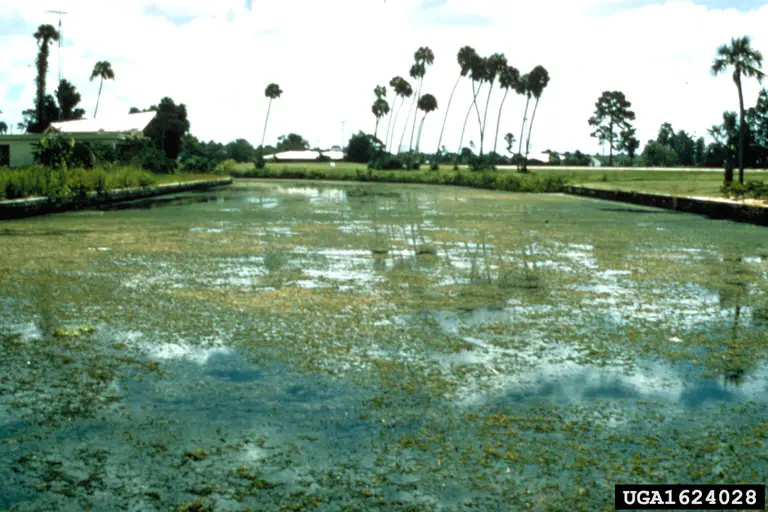
 Hydrilla – Hydrilla verticillata, often known as ‘hydrilla’ or ‘water thyme,’ is a highly invasive aquatic plant that forms a mat.
Hydrilla – Hydrilla verticillata, often known as ‘hydrilla’ or ‘water thyme,’ is a highly invasive aquatic plant that forms a mat.
The biotype discovered in the inlet is native to Southeast Asia and was introduced to America via the aquarium trade.
Leaves of the hydrilla are strap-like and pointed. It’s stem can grow up to 25 feet long! According to Cornell University, Hydrilla grows aggressively, up to a foot a day**.
Because pieces of the plant may grow roots and create new populations, Hydrilla can spread fast. Boats and boat trailers may readily catch and transport fragments, which can then be spread by wind and water currents.
Milfoil

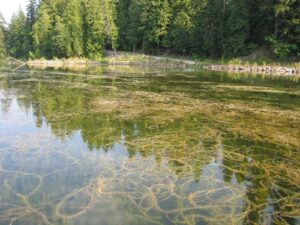 Milfoil – Milfoil is an invasive, non-native plant to the United States.
Milfoil – Milfoil is an invasive, non-native plant to the United States.
Its characterized by having long stalks, and will routinely reach the pond’s surface. Milfoil has feathery leaves arranged in four or five whorls around the stem.
Stems that reach the water’s surface frequently branch, forming a dense topwater canopy.
It may thrive in a range of environments, although it likes fine, organic particles on the pond floor***.
Although water milfoil offers some underwater shelter for fish and invertebrates, as well as food for certain animals, its fast development to nuisance levels restricts these values.
During the summer, rapid growth can decrease levels of dissolved oxygen, resulting in fish deaths.
Lily’s or Floating Hearts
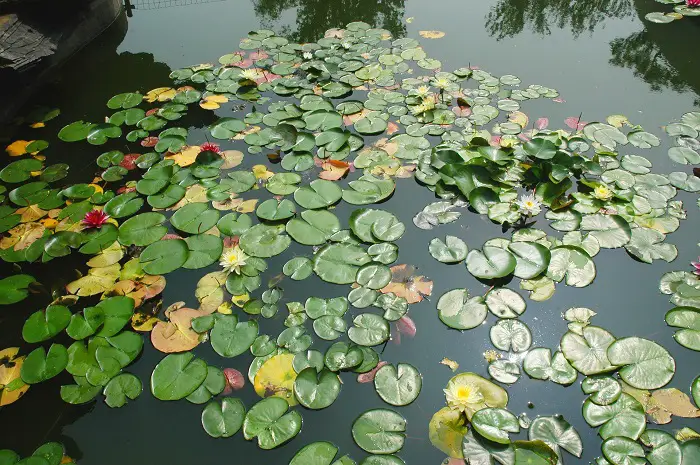
 Lily’s or Floating Hearts – Lily’s are native to the United States, and may be found in rivers, streams, and lakes with calm currents.
Lily’s or Floating Hearts – Lily’s are native to the United States, and may be found in rivers, streams, and lakes with calm currents.
Lily pads are round-to-oblong shaped, meaty, green on the surface and purple or red on the underside.
Most wildlife does not eat these plants, however many micro and macro invertebrates use the submerged parts of all aquatic plants as home.
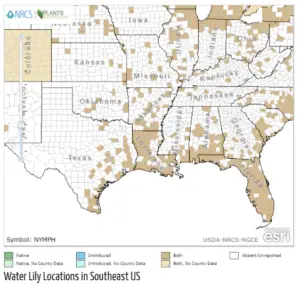 Bass and other animal species (e.g. amphibians, reptiles, ducks, etc.) consume these invertebrates as meals.
Bass and other animal species (e.g. amphibians, reptiles, ducks, etc.) consume these invertebrates as meals.
Breakdown of aquatic plants by bacteria and fungus also provides food (known as “detritus”) for many aquatic animals.
Cattails and Reeds
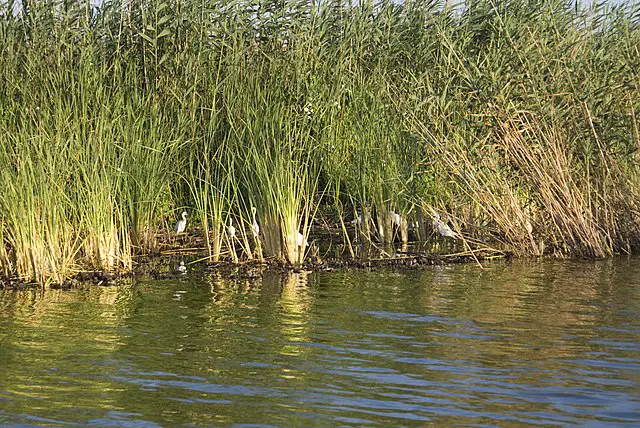
Cattails and Reeds – Cattails and reeds grow in large clumps or colonies along or near washes, irrigation ditches, streams, occasionally in marshes.
Cattails and Reeds have a hollow stem, and can be up to 2 inches thick.
They grow upright and can grow to a height of 6-18 feet long!
Reeds and cattails rarely branch.
These plants are great functioning as nature’s little nursery. Not only will it shelter nearly every small fish in the area, but frogs love these plants to croak on.
Oftentimes after a storm, it will blow the edges of the reeds down and will form a floating mat as well!
Worming over submerged grass tops...
Drag a light weight Mojo rigged worm over the tops of the grass, or throw a weightless Texas rigged Senko or ribbon tail worm.
A wacky rigged Senko also works really well over submerged grass.
Tap the tops of the submerged grass
Since you’re learning how to fish grass for bass here’s a great tip: If you like fishing fast you can use a squarebill crankbait, a lipless crankbait, or a swimbait to fish over the tops of the grass.
You’ll have the best chances of success of your lure taps the tops of the grass. You see, if it gets briefly hung up and you rip it away often you’ll get a massive reaction strike.
While it’s a little easier fishing with a soft plastic swimbaits and lipless crankbaits…
You’ll just have to count down to the right depth as it’s sinking.
Squarebill crankbaits are great at fishing submerged grass.
But you have to know exactly what depth the top of the grass is and how deep your crankbait will dive to.
Like most anglers, you can check your graph to see how tall the grass is growing under the water. However, it is hard to remember to know how deep all your crankbaits will dive to exactly.
Algae
Algae are a primordial type of plant. Algae can be tiny (planktonic algae). Others are hair-like or thin and stringy (filamentous algae).
When you get to your lake and see nasty algae bloom many anglers are afraid of fishing and algae and it’s really not a big deal if you understand it
What many anglers don’t understand is that you can learn how to fish around algae blooms, not in them and still catch fish.
Cyanobacteria, often known as blue-green algae, produces blooms that seem like spilled paint on the surface of a lake or pond. Blue-green algae come in a variety of shapes and sizes.
It’s the Golden Algae that can cause a fish kill in your lake. Good news is that it probably won’t kill all the fish in the lake. But, you really shouldn’t fish in a Golden Algae bloom.
Conversely, every other algae whether it’s blue-green, blue algae or whatever other color algae there is as long as it’s not Golden algae bass can be caught in it.
If you fish in water that has a clear to slightly stained water clarity and then all of a sudden the algae bloom hits and you have zero visibility a lot of people think you can’t catch bass.
Well I’m here to tell you that you can.
Algae will open up and bloom during the hottest portion of the day. It will, therefore, come to the surface.
That’s why, in the evenings, you have this heavy layer on top, then at night, the algae shuts closed and descends back down into the water column.
The algae isn’t as unpleasant when you fish first thing in the morning, but it becomes unbearable by lunchtime.
Even if the algae comes to the top and becomes dense and noxious, normal water color can be found only a few feet beneath the surface, and the fish do not care about this one bit.
If there is wind and large waves, it will have a significant negative impact on your day of fishing.
The water will be churned up by the wind, waves, and surges, forcing the algae to sink and mix the water. When this happens, algae causes a decrease in water clariy making them difficult to catch.
So you need to adapt.
How to fish in an algae bloom?
If your lake is normally clear to slightly stained and turns murky and muddy, you’ll need to change the colors and other aspects of the bait to assist the bass locate it.
Consider the following changes:
Switch to a dark opaque colored bait like a black and blue, or black and chartreuse.
Switch to a bait that has a stronger “thump”,
Switch to a bait that has a larger profile or a rattle
Summary
- Don’t freak out if you see blue-green algae.
- If you’re fishing in an area with algae, switch to a bait that is darker, larger, or louder to get the bass’ attention.
- If you notice golden algae move to a different area.
Do bass like one type of grass in a single area or if there's multiple types of grass present?

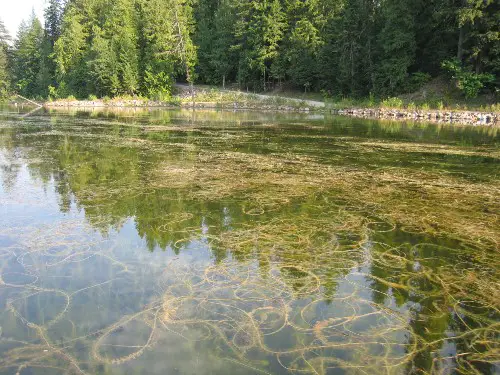
Bass will typically hang around areas that have multiple types of vegetation present. The reason being it gives the bass a buffet of opportunities to eat different critters.
Depending on the type of grass, some grass can grow to be very tall, which would be a great little hiding place for shad and other baitfish.
Other species of grass that is short and thick will give shelter to other species of bottom-dwelling baitfish and crawdads.
So it’s time to get a little nerdy…What is a thermocline?
I know you didn’t come here for a complete science lesson but I promise this is worth talking about.
The grass will grow best above the area called a thermocline. To make it easier for someone to understand, the thermocline is actually a separation within the water column into two layers, an upper and lower layer….
The area above the thermocline will have the most oxygen whereas the deeper levels of the lake will have less oxygen…
So naturally, we’ll find more life where there is more oxygen (the upper layer). And this friend is the layer you want to target when fishing.
Why is knowing this important to you? The next time when you’re on your boat find out how to find the thermocline on your fishfinder. Once you do that, fish everything about the thermocline for the rest of the day.
It will save you a TON of time and increase your chances of landing a monster bass.
This One Mistake Forced Me Miss 97% Of All Bites I Got...
When I was just learning bass fishing heavy grass, I can remember one of the biggest mistakes that I made was having this one wrong piece of equipment…
When I would get a bite and try to set the hook it would feel like I would set the hook with a rubber band! But, I was lucky enough to have my cousin take me out and we would flip into thick submerged grass.
And I would miss fish constantly!
It was so frustrating, in fact it was a little embarrassing. I thought I would never catch a bass in that deep grass.
But, I was lucky enough to have my cousin take me out and we would flip into thick submerged grass. He took one look and handed my something…
Sure enough… that was the difference maker…
...so what's was the Secret to catching bass in grass?
The answer may surprise you… it’s having the fishing specifically fishing rod designed to handle the rigors of fishing in and around vegetation.
Many anglers will classify this rod as a flipping rod.
There are many factors that go into determining what a flipping rod will look and feel like. Some of those factors include practical uses as style, length, material, and sensitivity, which we will explore individually.
Most avid anglers who flip into vegetation will use a casting rod. A casting rod is a special type of rod that also must be paired with a baitcasting reel.
Using a casting rod will give you increased casting distance, and increased accuracy for close quarters fishing. Something a spinning rod cannot do.
The best flipping rods are made from ultra-heated graphite. This gives the rod lightweight feel and gorilla-strong features.
Here are some best selling flipping rods for you to consider
| # | Preview | Product | Rating | |
|---|---|---|---|---|
| 1 |

|
Dobyns Rods Kaden Flipping / 7'6" / 1 PC / 12-25 LB Line Weight / 1/4-2 oz Lure Weight/Medium Heavy... | No ratings yet | Learn More |
| 2 |

|
Falcon Lowrider LFC-72HH Flippin Stik Casting 7' 2" Heavy | No ratings yet | Learn More |
| 3 |

|
Dobyns Rods Fury Series FR 765FLIP Heavy Flip Power Fast Action Flippin' Rod, 7'6", Black/Green | No ratings yet | Learn More |
#ad / Images from Amazon Product Advertising API
What’s the best reel for fishing grass?
For a reel, most avid bass anglers are going to choose a high-quality real with a fast gear ratio, greater than 6.1:1.
The higher gear ratio allows you to bring in more line per turn of the handle, so when that fish gobles your lure you can reel in the line fast!
You do not want that bass to further bury itself in the grass where it could gain the extra leverage to throw that bait.
Another important feature you need in a flipping reel for grass fishing is the reel must have an ultra strong drag system.
By tightening the drag as tight as it can go it prevents the fish from running. That means you can peg the fish to the grass and it stays pinned as you reel it in.
Here are some quality baitcasting reels for you to consider...
| # | Preview | Product | Rating | |
|---|---|---|---|---|
| 1 |

|
Shimano SLX 150, Low Profile Baitcasting Reel | No ratings yet | Learn More |
| 2 |

|
SEVIIN GF Casting Reel Right Hand (GFC173-R) | No ratings yet | Learn More |
| 3 |

|
KastKing Kestrel Air Micro Finesse Casting Reel, Ultralight Baitcasting Fishing Reel, Easily Casts... | No ratings yet | Learn More |
#ad / Images from Amazon Product Advertising API
What line do you use for flipping and pitching?
Far and away braid is the top choice of lines for flipping dense vegetation mats. Flourorcarcon can also be used for flipping in clear water or around rock or bridge pilings.
I’ve written a complete hands-on review on the best bass fishing line, where I outlined benefits each line has to offer and where I go over the durability issues that I ran into. If you want to learn about top bass fishing lines then click on the link below.
Read more: 21 Tips To Choose The Best Bass Fishing Line
| # | Preview | Product | Rating | |
|---|---|---|---|---|
| 1 |
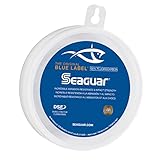
|
Seaguar Blue Label 100% Fluorocarbon Leader (DSF) 50yd 25lb | No ratings yet | Learn More |
| 2 |

|
Berkley Vanish® Leader Material, Clear, 25lb | 11.3kg, 40yd | 36m Fluorocarbon Fishing Line,... | No ratings yet | Learn More |
| 3 |

|
Seaguar AbrazX 100% Fluorocarbon Fishing Line 25lbs, 200yds Break Strength/Length - 25AX200 | No ratings yet | Learn More |
#ad / Images from Amazon Product Advertising API
What’s the best fishing knot for flipping and pitching?
How To Tie A Snell Knot: The Best Knot For Flipping Heavy Cover
BONUS TIP: Avoid casting out too far…
One of the biggest things professional bass anglers said to avoid is casting out too far.
When you cast out too far, it gives an unnatural presentation.
Also if you get a bit and you cast too far out, many times you wound feel the bass is actually swimming to you because you line is bent over that vegetation.
Try to keep your presentation as vertical as possible, flipping out only a 20 feet or so.
FAQ
How do I fish grass when it's windy?
Wind can either be your friend or foe depending on if you use it to your advantage.
Windy conditions will actually push the bait into a certain area. That will attract bass who are looking for an easy meal. Give mother nature a high-five because she just made your life a heck of a lot easier, you won’t have to go as far to search for those mouthy predators.
Strong winds also stir up the vegetation which puts more oxygen in the water, which causes the baitfish to go into a feeding frenzy which triggers the bass to feed.
Areas that are irregular such as pockets, points, bluff walls, steep banks, or isolated clumps of submersed grass all act as great corralling areas.
Fishing spinnerbaits around grass when it is breezy is probably the best way to catch bass in those conditions.
Look on your map and look around when you’re on the water to find small areas that could possibly corral the small baitfish when it’s really windy.
What is the best time of year for bass fishing heavy grass?
The best time of year to target bass grass or vegetation would have to be in the summertime and early fall. By then the vegetation will be at it’s fullest growth
Is it hard to flip in shallow grass?
Not at all. Depending on how thick the vegetation is you may need to downsize the weight you’re using. Most of the time, if you’re shallow the vegetation will not be as thick so you could get away using a lighter bait.
Want To Learn Where To Catch More Bass? Checkout These Articles...
- Bass Fishing CREEKS The Easy Way (In Less Than 10 Minutes)
- Warning: Bass Fishing HEAVY GRASS? [15+ Mistakes To Avoid]
- Bass Fishing POINTS in 5 Quick & EASY Steps!
- Complete 5-Step DOCK Fishing Formula
- Bass Fishing LAYDOWNS [Complete Guide + Pictures]
- Little Known Pattern for Fishing TREES for Bass.. Now and Forever
- Complete Formula For BASS FISHING ROCKY BANKS & RIPRAP
- The 5 TRUTHS about Bass Fishing BRIDGES and Avoid Wasting Time On Techniques That Don’t Work!
- Bass Fishing BRUSH PILES To Catch The Most Bass In Minimum Time!
- The 7-step Secret Formula for Bass Fishing LEDGES – Even a Complete Fishing Noob Can Use and Be 100 Times More Potent Than the Best B.A.S.S. Professional!
- The Single Best Guide to Fishing SHELL BEDS… and… Do It Fast!
- 5 Basic Elements Of Fishing HUMPS AND RIDGES No One is Talking About!
- 5 Crucial (and Unusual) Tactics You Must Do When Bass Fishing ROADBEDS!
- Top 25 Summer BANK Fishing Tips (Never Get Skunked Again)
- [EXPERT REVEALS] Bass Fishing In MUDDY WATER Secrets – 27 Tips & Mistakes To Avoid Today!
- 31 Best Tips for Bass Fishing At NIGHT (Complete Guide)
Checkout These Other Summer Fishing Articles...
- Complete 5-Step Formula For BASS FISHING DOCKS
- The 7-step Secret Formula for BASS FISHING LEDGES – Even a Complete Fishing Noob Can Use and Be 100 Times More Potent Than the Best B.A.S.S. Professional!
- Top 25 Summer Bank Fishing Tips (Never Get Skunked Again)
- Bass Fishing In Heavy Grass? [17+ Mistakes To Avoid]
- 7 Top Secret Weedless Bass Lures for Flipping into Heavy Grass -Exposed!
- How To Fish A Crankbait [TOP 10 Essential Secrets To Catching Bass With A Crankbait]
- 15 Best Deep Diving Crankbaits [2023 Buyers Guide – Which to Buy & Avoid]
- Fish a Flutter Spoon The RIGHT way... like the Pros... And Do It TODAY!
- NEW and truly "no brainer" (yet usually overlooked) way to MASTER SOFT PLASTIC PADDLE TAIL SWIMBAITS and increase the amount of bass you catch 100% or more... automatically!
- Top 5 questions and challenges every about hair jig fishing... AND how to overcome common problems most anglers encounter (and then prematurely quit).
- Top 10 Best Jigs For Bass Fishing [Insiders Only]
- Avoid this ONE Texas rig fishing NIGHTMARE - And increase your Texas rig fishing expertise FAST!
- 31 Best Tips for Bass Fishing At NIGHT (Complete Guide)
- 2023 Buyers Guide Best GREEN FISHING LIGHT [LED FISHING LIGHTS Reviews & Tips]
- Dock Lights For Night Fishing [Best Products, Secrets, & Tips]
Other Bass Fishing Articles Just For You...
Funny Fishing Rules, Laws, and Regulations 2025
Crazy Fishing Laws That Will Blow Your Mind! #7 is INSANE! Strange Fishing Regulations and Laws As silly as hook and rod limits may seem,
EXPOSED! How To Use A Spinnerbait The Right Way for 2025
Are You Wondering How To Use A Spinnerbait? Or How To Work A Spinnerbait Over Grass, Logs, or Points? Well, All These Questions Are Answered
EXPOSED! Best Crankbait Colors for 2025 [Which to Buy & Avoid]
What color crankbait to use? Crankbait Color Chart I just love going into a Bass Pro Shops store and just staring at all the walls
Best Underwater Dock Lights For Fishing – 2025 Buyers Guide
Night Dock Light Fishing For Beginners Dear fellow angler, Does this sound like you? You’re someone who loves fishing but just wants to escape the
15 Best Deep Diving Crankbaits [2025 Buyers Guide – Which to Buy & Avoid]
A Complete Buyer’s Blueprint On The Best Deep Diving Crankbaits for Bass, Walleye, or Striped Bass On The Market Today Fishing deep diving crankbaits can

